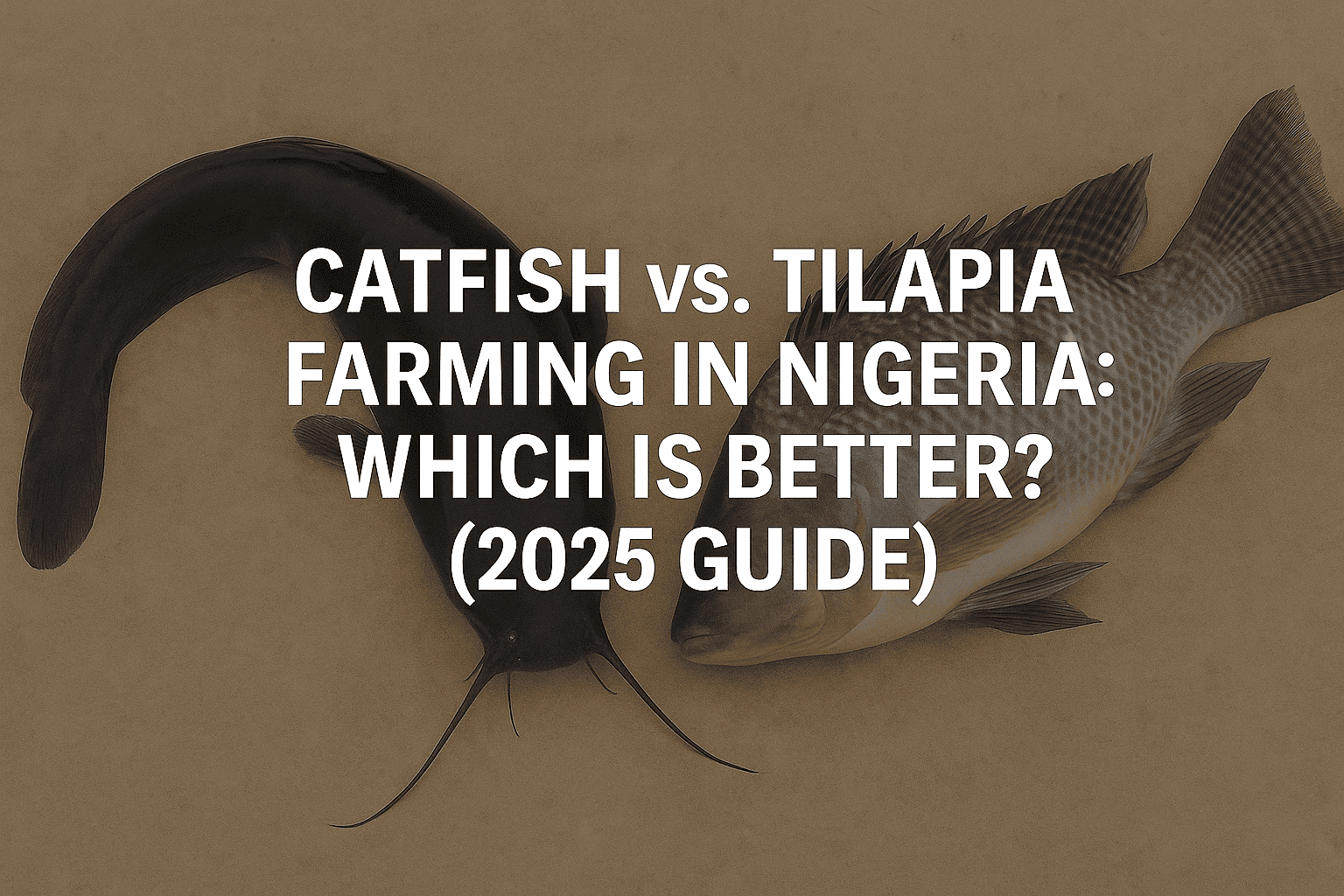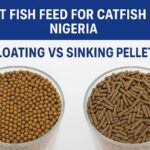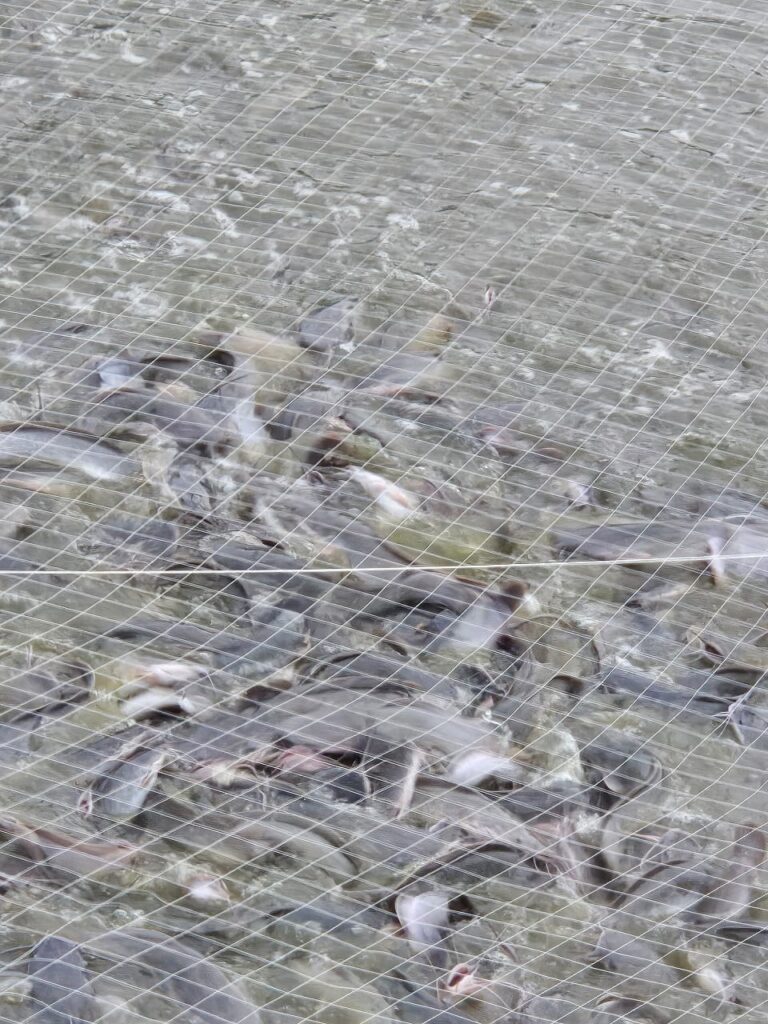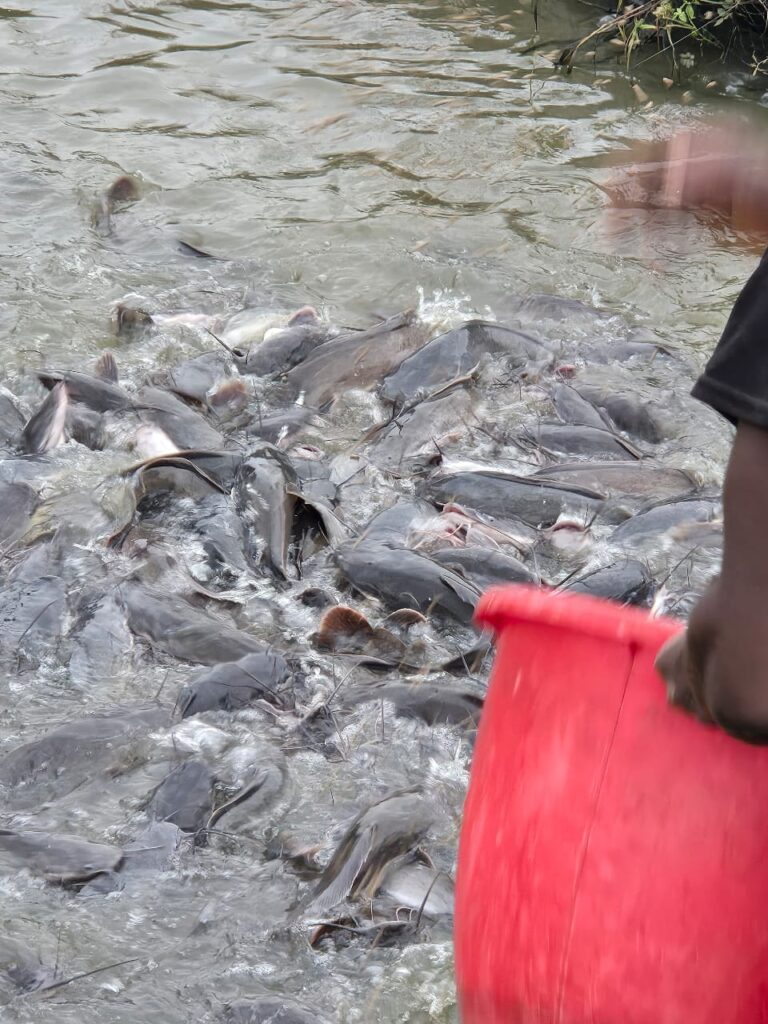Fish farming in Nigeria has grown rapidly over the years, becoming a key part of the country's agricultural sector. With the increasing demand for affordable sources of protein, aquaculture has emerged as a profitable venture for both small- and large-scale farmers. Among the most popular species farmed are catfish and tilapia, each offering unique advantages …
Fish farming in Nigeria has grown rapidly over the years, becoming a key part of the country’s agricultural sector. With the increasing demand for affordable sources of protein, aquaculture has emerged as a profitable venture for both small- and large-scale farmers. Among the most popular species farmed are catfish and tilapia, each offering unique advantages and challenges.
Choosing the right fish species is one of the most important decisions a farmer must make when starting or scaling a fish farming business. The species you select can significantly impact your farm’s profitability, ease of management, and overall success.
In this post, we’ll explore the key differences, benefits, and challenges of catfish farming vs. tilapia farming. Whether you’re a new farmer or looking to diversify your operations, this guide will help you make an informed choice based on your goals, budget, and local market demand.
Habitat and Biological Differences: Catfish vs. Tilapia
Understanding the difference between catfish and tilapia farming begins with examining their habitat preferences, water requirements, and breeding behaviours—factors that directly affect farm setup and management.
1. Habitat and Water Requirements
Catfish are hardy and can tolerate a wide range of water conditions, including low oxygen levels and high turbidity. They thrive in ponds, tanks, and even recirculating aquaculture systems (RAS). Tilapia, on the other hand, prefer clean, warm, and well-oxygenated water. They are sensitive to poor water quality and require consistent monitoring to thrive.
2. Stocking Density
Catfish can be stocked more densely due to their resilience and tolerance for crowded environments, which can lead to higher yields per pond. Tilapia require more space per fish to avoid stress, stunted growth, and disease outbreaks, meaning their stocking density is usually lower compared to catfish.
3. Breeding Behaviour
Catfish breeding often requires hormone-induced spawning or controlled environments, making it slightly more technical. Tilapia, however, are prolific breeders and can reproduce naturally in ponds without much intervention. While this may seem like an advantage, uncontrolled tilapia breeding can lead to overpopulation and poor growth rates if not properly managed.
Feeding and Growth Rate: Which Fish Grows Faster and Cheaper?
Feeding is one of the most critical and costly aspects of fish farming. Comparing the catfish and tilapia growth rate and feed requirements can help farmers determine which species offers better value for money.
1. Types of Feed Required
Both catfish and tilapia thrive on commercial pellet feeds, but their nutritional needs differ. Catfish require protein-rich feed—especially during the early stages—to support rapid growth and muscle development. Tilapia, being omnivorous, can tolerate lower protein levels and can even be supplemented with locally available feed materials like plant leaves or kitchen waste, which can significantly reduce feed costs.
2. Growth Rates and Feed Conversion Efficiency
When comparing catfish and tilapia growth rates, catfish generally take longer to reach market size, around 5 to 6 months. However, they grow larger and fetch higher prices. Tilapia reaches harvest size in 4 to 5 months, but the individual fish are smaller.
Tilapia tend to have better feed conversion ratios (FCR), meaning they convert feed into body mass more efficiently than catfish. This makes them more economical to feed in the long run.
3. Cost-Effectiveness of Feeding
When it comes to tilapia vs. catfish feed cost, tilapia is generally cheaper to feed and may offer lower operational costs. However, catfish farming often compensates for higher feed costs with better selling prices and denser stocking capacity, leading to higher overall revenue per pond. In summary, tilapia may be more feed-efficient and cost-effective, but catfish offer better returns when well-managed, making the choice dependent on your budget, feed access, and market goals.
Stocking Density and Space Requirements
Effective space and stock management are vital for healthy fish growth and maximising yield. While both catfish and tilapia are adaptable species, their stocking density and space needs vary, influencing how you design and manage your farm.
1. Best Practices for Stocking Each Species
Catfish are more tolerant of crowded environments and can be stocked at higher densities, especially in tarpaulin ponds, concrete tanks, or recirculating systems. A common practice is 80 to 120 fingerlings per square meter, depending on water quality and feeding efficiency.
Tilapia, on the other hand, are less tolerant of overcrowding. They require more space per fish to reduce stress, avoid stunted growth, and minimise disease outbreaks. An ideal stocking density for tilapia is around 30 to 50 fingerlings per square meter in well-aerated ponds.
2. Optimal Pond/Tank Sizes and Water Depths
Catfish thrive in deeper ponds or tanks—typically around 1 to 1.5 meters deep—to accommodate their bottom-dwelling behaviour and high waste output. Tilapia prefer slightly shallower water—around 0.8 to 1.2 meters deep—and benefit from wider surface areas for better oxygen diffusion.
3. Managing Overcrowding Risks
Overcrowding increases the risk of oxygen depletion, disease outbreaks, poor growth, and mortality. For catfish, regular water changes, aeration, and grading by size can help manage density issues. For tilapia, controlling natural breeding is also essential—otherwise, their tendency to reproduce quickly can result in overpopulation and stunted fish sizes.
By following proper stocking density guidelines and pond management practices, farmers can avoid unnecessary losses and ensure consistent growth in both catfish and tilapia systems.
Breeding and Reproduction: Understanding the Lifecycle Differences
Breeding plays a vital role in maintaining a sustainable fish farming operation. The reproductive behaviour, ease of breeding in captivity, and fry survival rates vary significantly between catfish and tilapia, which directly affects hatchery decisions and long-term farm planning.
1. Breeding Behaviour and Lifecycle
Tilapia are natural breeders and will reproduce readily in ponds without much intervention. They are mouthbrooders—meaning the female carries fertilised eggs and newly hatched fry in her mouth for protection, which increases early survival chances. This makes tilapia ideal for farmers looking for a self-sustaining population.
Catfish, however, require more effort to breed. They typically do not spawn naturally in controlled environments like tanks or tarpaulin ponds. Instead, farmers often rely on induced breeding using synthetic hormones and controlled environments such as hatchery tanks. After hatching, catfish fry must be carefully monitored due to their vulnerability to poor water quality and cannibalism.
2. Ease of Breeding in Captivity
Tilapia’s ability to breed naturally in captivity makes them a convenient choice for small-scale or low-budget farmers. However, this can lead to overbreeding and overcrowding if not carefully managed through sexing or the use of monosex fingerlings.
Catfish breeding is more technical and usually requires skilled labour and equipment, but it allows for better control over the number and timing of new fingerlings. This makes catfish breeding more suitable for commercial hatchery setups.
3. Fry Survival Rates
Tilapia fry generally have higher survival rates due to the protective nature of their breeding process. With good water quality and feed, survival rates can exceed 80%. In contrast, catfish fry are more fragile and prone to mortality if proper care is not taken—survival rates can vary widely depending on water conditions, temperature, and management practices.
In conclusion, tilapia offers easier and more frequent breeding, while catfish requires a more controlled and technical approach, but allows for better population planning.
Disease Resistance and Mortality: Health Challenges in Catfish and Tilapia Farming
Maintaining healthy fish stock is essential for profitable aquaculture. Both catfish and tilapia are generally hardy species, but their susceptibility to diseases and how they respond to treatment differ. Understanding these differences helps farmers minimise losses and improve overall productivity.
1. Common Diseases Affecting Catfish and Tilapia
Catfish are prone to bacterial infections like columnaris, fungal infections, and parasitic infestations, especially in overcrowded or poorly managed systems. Injuries from aggressive behaviour—common among catfish—can also lead to secondary infections.
Tilapia, while more peaceful, are vulnerable to diseases like Streptococcus, Aeromonas, and parasitic infestations, especially in warm, low-oxygen waters. Tilapia farms that do not control natural breeding often experience stress-related diseases due to overcrowding.
2. Preventive Measures and Treatment Cost
For both species, prevention is more cost-effective than treatment. Good water quality, proper feeding, regular pond maintenance, and biosecurity measures like disinfection and quarantine can reduce disease outbreaks.
Treating catfish diseases often involves the use of antibiotics or antifungal medications, which can be expensive and, if misused, lead to drug resistance. Tilapia treatment typically involves salt baths, probiotics, or commercial medications, which are slightly less costly due to tilapia’s smaller size and milder disease profile.
3. Mortality Rate Comparisons
Tilapia generally have lower mortality rates under well-managed conditions thanks to their disease resistance and peaceful nature. In contrast, catfish can suffer higher mortality if proper care is not taken—especially during the fry and fingerling stages when they are more vulnerable to stress and cannibalism.
In summary, while both species require vigilance, tilapia tend to be easier to manage in terms of health, making them a lower-risk option for beginners. Catfish, with higher disease susceptibility, demand closer monitoring and more advanced health management practices.
Catfish vs Tilapia Profitability: A Deeper Financial Comparison
When considering which fish to farm, understanding the catfish vs tilapia profitability equation is critical for making informed business decisions. Let’s take a closer look at how these species compare in terms of production cycles, cost-to-price ratios, and return on investment.
1. Production Cycle Length
Tilapia generally have a shorter production cycle, reaching market size in about 4 to 5 months. Catfish, in contrast, require around 5 to 6 months to reach full maturity. This faster turnaround time gives tilapia farmers the opportunity for more frequent harvests in a year, which can help with cash flow and reinvestment.
2. Cost of Production vs Selling Price
Catfish typically have higher feed requirements, especially during the grow-out phase, and may involve more intensive management, particularly in controlled systems. This leads to higher production costs per cycle. However, catfish also command higher market prices, especially when sold live or smoked, which can offset the cost.
Tilapia farming tends to be less expensive due to their lower protein feed requirements and ease of breeding. However, they often sell for a slightly lower price per kilogram in most Nigerian markets.
3. Return on Investment (ROI) Analysis
Despite higher production costs, catfish often offer higher ROI due to favourable market prices, denser stocking capacities, and strong consumer demand. Tilapia, with its lower production costs and faster cycle, may yield a steady but moderate ROI, especially for farmers who manage space and breeding well.
In essence, catfish vs tilapia profitability is a balance of cost, time, and market pricing. Catfish is more profitable for those with sufficient capital and management skills, while tilapia is better suited for farmers seeking low-entry investment and faster turnaround.nd
Market Demand and Consumer Preferences
Understanding market demand is crucial when choosing between catfish and tilapia farming. Consumer behaviour, regional preferences, and even religious or cultural factors can significantly influence your sales and profitability.
1. Nigerian Consumer Demand by Region
Catfish enjoys widespread popularity across Nigeria, especially in the South and urban centres like Lagos, Abuja, and Port Harcourt. It is a staple in many local dishes, such as catfish pepper soup, grilled catfish (point-and-kill), and smoked catfish used in soups and stews. This makes it a top choice for restaurants, roadside vendors, and household consumers in these regions.
Tilapia, though not as universally consumed, has a solid market in certain northern and middle-belt states, and among health-conscious consumers nationwide. It’s often seen as a healthier, leaner fish and is commonly served grilled or fried in middle-income households and eateries.
2. Market Size and Buyer Behaviour
The market for catfish in Nigeria is large and growing, driven by its high demand in both fresh and processed forms. Many farmers target live markets, restaurants, and bulk buyers who prefer smoked or dried catfish. Buyers often focus on fish size and freshness, and are willing to pay a premium for well-grown, healthy catfish.
The tilapia market, while slightly smaller, is more stable and predictable. Tilapia buyers are usually price-sensitive and may prefer regular, smaller-sized fish. Sales are common in supermarkets, frozen food outlets, and health-focused markets.
3. Religious and Cultural Influences on Consumption
Religious and cultural beliefs can also shape demand. In predominantly Muslim regions, both catfish and tilapia are acceptable, though tilapia may be preferred due to its cleaner image and fewer visible blood vessels. In southern Nigeria, catfish is deeply integrated into cultural cuisine and festivities, boosting its demand further.
In summary, understanding your local consumer base is essential. Catfish offers a broader and more lucrative market, especially in southern and urban areas, while tilapia caters to a more specific but loyal customer segment that values health and affordability.
Environmental Impact: Sustainability Considerations in Catfish and Tilapia Farming
As fish farming in Nigeria expands, the environmental impact of aquaculture is becoming an important consideration. Choosing between catfish and tilapia farming isn’t just about profitability—it also involves understanding the long-term effects on the environment, water bodies, and surrounding ecosystems.
1. Waste Management and Sustainability
Catfish farming, particularly in high-density systems like tarpaulin ponds and tanks, generates a significant amount of organic waste, including uneaten feed, faeces, and mucus. If not properly managed, this waste can lead to the buildup of ammonia and other harmful compounds, affecting fish health and the surrounding environment. Regular water changes, biofilters, and proper pond maintenance are essential for sustainable catfish farming.
Tilapia farming tends to be more eco-friendly in terms of waste production. Tilapia consume less protein and produce lower waste output per kilogram of feed. They can also thrive in integrated farming systems, such as aquaponics, where their waste can be used to fertilise plants, further promoting sustainability.
2. Risk of Water Pollution and Invasive Tendencies
Both species pose environmental risks if poorly managed. Overflow from ponds can lead to water pollution, affecting nearby water bodies and aquatic life. Catfish farming, when done at a large scale without proper effluent control, can contribute to oxygen depletion and eutrophication in nearby rivers or lakes.
Tilapia, on the other hand, is known for its invasive tendencies. If accidentally released into open water bodies, tilapia can outcompete native fish species, disrupt ecosystems, and cause long-term ecological imbalances.
3. Eco-Friendliness of Both Fish
From an environmental standpoint, tilapia is often considered more eco-friendly due to its lower feed requirements, better feed conversion efficiency, and potential for integrated farming. Catfish farming can also be sustainable when modern waste management systems, proper water recycling, and responsible farming techniques are applied.
In conclusion, both fish can be farmed sustainably, but tilapia has a slight edge in eco-friendliness—especially for farmers interested in low-impact aquaculture and environmental stewardship.
Summary and Final Recommendation
Both catfish and tilapia offer unique opportunities and challenges for fish farmers in Nigeria. Understanding their differences helps ensure that your investment aligns with your goals, resources, and local market conditions.
Summary of Key Differences:
| Factor | Catfish | Tilapia |
|---|---|---|
| Growth Rate | Slower (5–6 months) | Faster (4–5 months) |
| Feed Cost | Higher | Lower |
| Stocking Density | High | Moderate |
| Breeding | Technical (requires hormone induction) | Natural (prolific breeders) |
| Market Price | Higher | Moderate |
| Consumer Demand | Very high in urban and southern Nigeria | Moderate, strong in health-conscious and northern markets |
| Environmental Impact | High waste output | Lower waste, but risk of invasive spread |
| Disease Resistance | Moderate, higher mortality in fry | Generally hardy with lower mortality |
Recommendation:
-
If your goal is higher profit margins and you have the resources to manage more intensive systems (like feeding, waste control, and technical breeding), catfish farming is likely the better option—especially in urban or southern Nigerian markets with high demand.
-
If you’re looking for a lower-cost, beginner-friendly fish with fast turnover and easier breeding, tilapia farming is a great choice. It’s especially ideal for integrated farms or rural setups with clean water access and less infrastructure.
Ultimately, the decision between catfish farming vs tilapia farming should be based on your available capital, local market preferences, farm setup, and long-term business strategy. Either way, fish farming remains a promising and profitable venture in Nigeria when managed correctly.
Are you a fish farmer in Nigeria? Share your experience with us on Catfish and Tilapia Fish in the comments below!
You can contact us through our contact form for your quality local fish feed, fish, agricultural produce, fish farming consultations and farm management support.
For more exclusive farming tips and advice, check out our YouTube channel to stay updated with the latest news on fish farming and agriculture in general.






